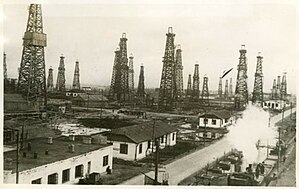Economic history of Azerbaijan
- Economic History of Azerbaijan
The economic history of Azerbaijan covers the development of the country's economy from its incorporation into the Russian empire at the beginning of the 19th Century, through the period of independence under the Democratic Republic (1918-1920), as part of the Soviet Union (1920-1991), and the subsequent transition to the Republic of Azerbaijan (post-1992).
- The Economy of Azerbaijan in the Period of Azerbaijan Democratic Republic
From 1918 to 1920, the government of the Democratic Republic of Azerbaijan worked to restore the Azerbaijani economy, which had declined following the overthrow of tsarism. In 1919, the State Budget of Azerbaijan amounted to 665 million manats, primarily replenished by selling oil and levying profit tax at 30%. Other fiscal revenues came from excise taxes on wine, tobacco, and oil. Custom services contributed 100 million manats, with an additional 15 million manats from duties on free trade, freight, and passenger transportation. Azerbaijan was predominantly an agrarian country, focusing on animal husbandry, with significant livestock numbers. Bartering was common, with oil exchanged for imported goods. Azerbaijan paid for military goods, telephone sets, cars, locomotives, tanks, wagons, and food products from various countries, mainly with oil, cotton, wool, silk, and leather.
The export of Azerbaijani oil declined significantly following the Russian Revolution. In 1919, only 600 thousand tons of oil were exported from the 3.6 million tons produced. Exporting oil to Europe became possible after the restoration of the Baku-Batumi oil pipeline in 1919 and the construction of the Baku-Julfa railway.
- Within the Soviet Union

The economic structure of Azerbaijan continued to develop slowly during 1920-1939, focusing on oil, gas, chemical, light industries, food processing, machine building, and metalworking. Post-World War II, all economic sectors were adjusted to peacetime requirements. In 1948, the republic's industry produced more goods than in prewar years. By 1950, industrial goods production increased by 39% compared to 1940. In the 1950s and 1960s, Azerbaijan's industry intensified, with improved regional and sectoral structures. Industrial goods output increased by 5.5 times compared to 1940. Major factories and facilities, such as the pipe production plant in Sumqayit and the Ganja aluminum smelter, were built and operational by the 1970s.
- Years of Independence
Since gaining independence in 1991, Azerbaijan has pursued an independent economic policy. The dissolution of the Soviet Union severely damaged Azerbaijan's economy, with the poverty rate reaching 49% in 2001. By 2013, the gross national income per capita was $7,350, GDP per capita was $7,912.5, and the poverty rate decreased to 5%. The exploitation of hydrocarbon resources has been pivotal in Azerbaijan's economic development, along with foreign investments and agreements. The transition to a market economy through relevant reforms has been a primary objective.
The first period of economic development (1991-1995) was marked by economic recession, while the period after 1996 saw dynamic economic growth. Independence led to economic decline, with GDP shrinking until 1996, aggravated by the situation with Armenia. In 1994, a significant oil contract, "the Contract of Century," was signed between Azerbaijan and 13 major oil companies. The Baku-Tbilisi-Ceyhan oil pipeline and the Shah Deniz gas field contract were also signed in the 1990s. The oil-gas sector contributed to the flourishing of other economic sectors, with new reforms aimed at macroeconomic and financial stability. Azerbaijan joined international institutions like the IMF, World Bank, and EBRD. The poverty rate decreased from 68% in 1995 to 29% in 2005 due to economic growth.
In 2005, the manat was revalued at the rate of 5,000 to 1 new manat (AZN). Between 2005 and 2010, the average annual growth rates of "oil" GDP were more than 3.5 times higher than the increase in "non-oil" GDP. The share of the oil sector in the country's GDP rose from 39% to 60%. Bank loans and government incentives contributed to the rapid growth of non-oil industries. Significant growth in the construction industry and service sector led to the non-oil sector overtaking the oil industry in growth rates by 2010.
Three five-year programs related to socio-economic development were implemented between 2004 and 2013, aimed at economic diversification. These programs included "State Programs for Social and Economic Development for 2014-2018," "State Programs on Poverty Reduction and Sustainable Development in the Republic of Azerbaijan for 2008-2015," and "State Programs for reliable food supply of the population of the Republic of Azerbaijan for 2008-2015."
The estimates of the Davos World Economic Forum showed that Azerbaijan's economy ranked 38th in the world for the level of competitiveness.
- References
- External Links
- [Economic Development in Azerbaijan](http://www.ppi.az/publication/boosting-economic-growth-in-azerbaijan-through-economic-diversification/) Archived 2023-05-01 at the Wayback Machine
This article "Economic history of Azerbaijan" is from Wikipedia. The list of its authors can be seen in its historical and/or the page Edithistory:Economic history of Azerbaijan. Articles copied from Draft Namespace on Wikipedia could be seen on the Draft Namespace of Wikipedia and not main one.
